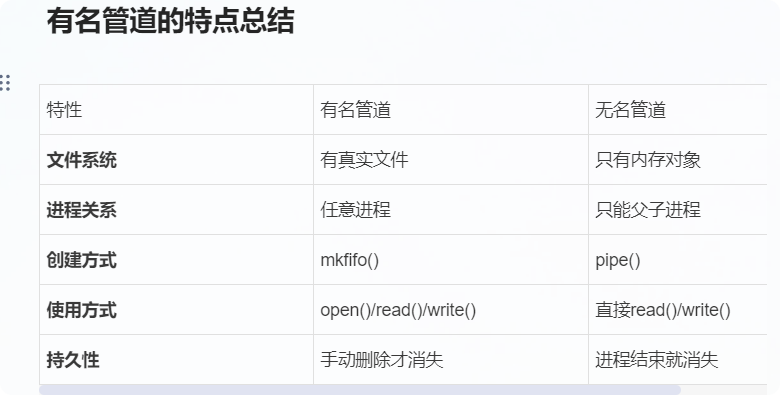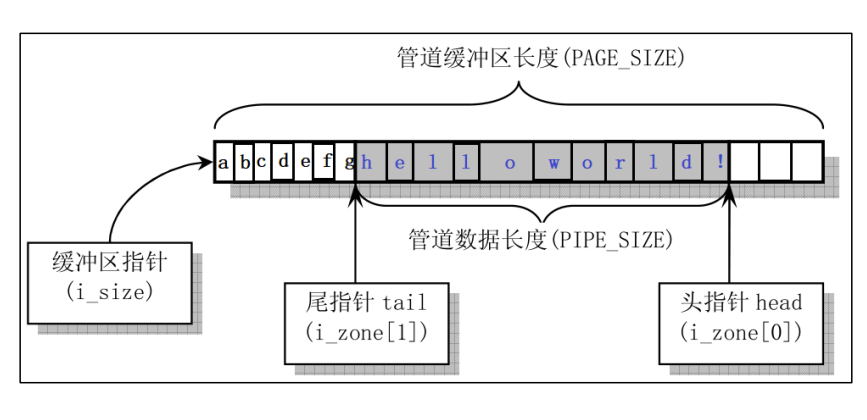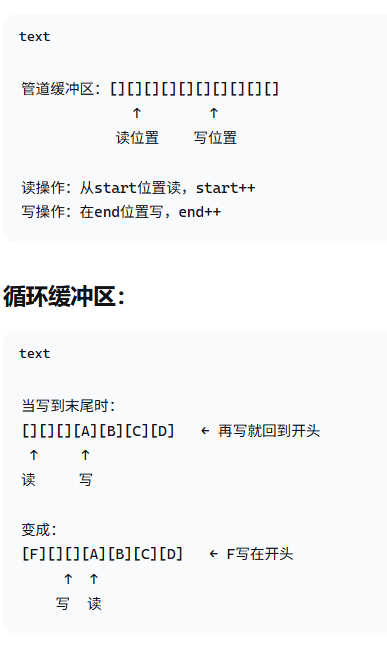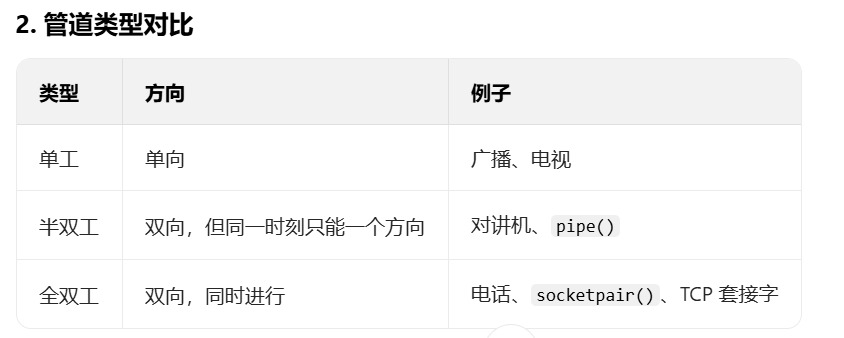perror的作用:
perror 是 C 语言标准库函数,用于便捷输出系统调用错误信息:
- 头文件:需包含 。
- 原型:void perror(const char *s);,接收一个字符串参数 s。
- 功能:结合全局变量 errno(系统调用失败时会被设置以指示错误类型),先输出传入的字符串 s,再输出冒号、空格,最后输出与当前 errno 对应的系统错误描述。
- 用途:调试时快速定位系统调用类错误(如文件操作失败等),提升调试效率。
进程间通信(IPC)
管道 信号量 共享内存 消息队列 套接字
管道
管道就像一根水管:
- 一端进水(写数据)
- 一端出水(读数据)
- 数据像水一样单向流动
// 可视化理解:进程A → [写端] === 管道 === [读端] → 进程B(进水口) (出水口)
管道的基本特性
关键特点:
- 单向通信:数据只能从一个方向流
- 字节流:没有消息边界,就是一连串字节
- 内核缓冲:内核负责缓存数据
- 父子进程:通常用于有亲缘关系的进程
最简单的管道例子
#include <stdio.h>
#include <unistd.h>
#include <string.h>
int main() {
int pipefd[2]; // 管道文件描述符数组
char buf[100];
// 创建管道
if (pipe(pipefd) == -1) {
perror("pipe创建失败");
return 1;
}
printf("管道创建成功!\n");
printf("pipefd[0] = %d (读端)\n", pipefd[0]);
printf("pipefd[1] = %d (写端)\n", pipefd[1]);
// 写入数据到管道
char* message = "Hello Pipe!";
write(pipefd[1], message, strlen(message) + 1); // +1包含\0
printf("写了数据到管道: %s\n", message);
// 从管道读取数据
read(pipefd[0], buf, sizeof(buf));
printf("从管道读到数据: %s\n", buf);
// 关闭管道
close(pipefd[0]);
close(pipefd[1]);
return 0;
}
编译和运行
gcc -o pipe_demo pipe_demo.c
./pipe_demo
输出:
管道创建成功!
pipefd[0] = 3 (读端)
pipefd[1] = 4 (写端)
写了数据到管道: Hello Pipe!
从管道读到数据: Hello Pipe!
关键概念详解
pipe() 函数:
int pipefd[2];
pipe(pipefd);
- 创建两个文件描述符:
- pipefd[0] - 读端(像出水口)
- pipefd[1] - 写端(像进水口)
数据流向:
write(pipefd[1], data) → 管道缓冲区 → read(pipefd[0], buf)
↑ ↑ ↑
写端 内核管理 读端
管道的阻塞特性
重要行为:
// 情况1:管道空时读操作
read(pipefd[0], buf, size); // 会阻塞,直到有数据可读
// 情况2:管道满时写操作
write(pipefd[1], data, size); // 会阻塞,直到有空间可写
// 情况3:所有写端关闭
read(pipefd[0], buf, size); // 返回0 (EOF)
无名管道(只能父子进程)
#include <stdio.h>
#include <unistd.h>
#include <string.h>
#include <sys/wait.h>
int main() {
int pipefd[2];
char buf[100];
pid_t pid;
// 1. 父进程创建管道
pipe(pipefd);
pid = fork();
if (pid == 0) {
// 子进程:只写不读
close(pipefd[0]); // 关闭读端(不用就关掉)
char* message = "Hello from Child!";
write(pipefd[1], message, strlen(message) + 1);
printf("子进程写了: %s\n", message);
close(pipefd[1]); // 写完关闭写端
exit(0);
} else {
// 父进程:只读不写
close(pipefd[1]); // 关闭写端(不用就关掉)
read(pipefd[0], buf, sizeof(buf));
printf("父进程读到: %s\n", buf);
close(pipefd[0]); // 读完关闭读端
wait(NULL); // 等待子进程结束
}
return 0;
}
有名管道的使用:(任意两个进程间通信)
好的!有名管道(FIFO)来了!这个比无名管道简单直观很多。
有名管道 vs 无名管道
无名管道(刚学的):
// 像电话线:临时连接,挂断就没了
pipe(pipefd); // 内存中创建,没有文件名
// 只能父子进程用
有名管道(现在学的):
最基础的有名管道使用
// 像邮箱:有地址,谁都可以往里投信
mkfifo("/tmp/myfifo", 0666); // 文件系统中创建真实文件
// 任意进程都能用
步骤1:创建FIFO文件
#include <stdio.h>
#include <sys/stat.h>
#include <fcntl.h>
#include <unistd.h>
int main() {
// 创建有名管道(像创建文件一样)
if (mkfifo("/tmp/myfifo", 0666) == -1) {
perror("mkfifo");
return 1;
}
printf("有名管道创建成功:/tmp/myfifo\n");
return 0;
}
编译运行:
gcc -o create_fifo create_fifo.c
./create_fifo
ls -l /tmp/myfifo # 看到:prw-r--r-- 开头的p表示管道文件
实际通信例子:两个独立进程
进程A:写数据
// writer.c
#include <stdio.h>
#include <fcntl.h>
#include <unistd.h>
#include <string.h>
int main() {
int fd;
char* message = "Hello FIFO!";
// 打开FIFO文件(会阻塞,直到有进程来读)
printf("写进程等待读进程连接...\n");
fd = open("/tmp/myfifo", O_WRONLY);
// 写入数据
write(fd, message, strlen(message) + 1);
printf("写进程发送: %s\n", message);
close(fd);
return 0;
}
进程B:读数据
// reader.c
#include <stdio.h>
#include <fcntl.h>
#include <unistd.h>
int main() {
int fd;
char buf[100];
// 打开FIFO文件(会阻塞,直到有进程来写)
printf("读进程等待写进程连接...\n");
fd = open("/tmp/myfifo", O_RDONLY);
// 读取数据
read(fd, buf, sizeof(buf));
printf("读进程收到: %s\n", buf);
close(fd);
return 0;
}
测试方法
开两个终端窗口:
终端1(读进程):
gcc -o reader reader.c
./reader
# 输出:读进程等待写进程连接... (会卡在这里)
终端2(写进程):
gcc -o writer writer.c
./writer
# 输出:写进程等待读进程连接...
# 写进程发送: Hello FIFO!
然后终端1自动显示:
读进程收到: Hello FIFO!
有名管道的阻塞特性
关键行为:
// 情况1:只有读进程
open("/tmp/myfifo", O_RDONLY); // 阻塞,等写进程
// 情况2:只有写进程
open("/tmp/myfifo", O_WRONLY); // 阻塞,等读进程
// 情况3:读写进程都到位 → 同时继续执行
有名管道的实际应用场景
场景1:Shell命令使用FIFO
# 终端1:创建FIFO并读取
mkfifo /tmp/myfifo
cat /tmp/myfifo
# 终端2:写入数据
echo "Hello" > /tmp/myfifo
# 终端1立即显示:Hello
场景2:多个写进程,一个读进程
// 多个进程都可以往同一个FIFO写数据
// 读进程会收到所有数据

清理FIFO文件
// 程序结束时删除FIFO文件
#include <stdio.h>
#include <unistd.h>
int main() {
// 使用FIFO...
// 最后删除
unlink("/tmp/myfifo");
printf("FIFO文件已删除\n");
return 0;
}
或者手动删除:
rm /tmp/myfifo
有名管道的核心思想:
- 先建"邮箱":mkfifo 创建管道文件
- 写信投递:写进程 open + write
- 收信阅读:读进程 open + read
- 双方配合:缺一方就阻塞等待
比无名管道简单的地方:
- 不用操心文件描述符继承
- 不用关系进程亲缘
- 像普通文件一样操作
管道的使用规则
规则1:及时关闭不用的端
// 如果只读不写,就关闭写端 close(pipefd[1]);
// 如果只写不读,就关闭读端 close(pipefd[0]);
规则2:理解数据流
父进程 → 子进程:
父: close(pipefd[0]); write(pipefd[1]);
子: close(pipefd[1]); read(pipefd[0]);
子进程 → 父进程:
子: close(pipefd[0]); write(pipefd[1]);
父: close(pipefd[1]); read(pipefd[0]);
常见问题解答
Q: 为什么要在父子进程中都关闭不用的端?
A: 因为文件描述符会被继承,如果不关闭:
- 读进程不关闭写端 → 永远读不到EOF
- 写进程不关闭读端 → 浪费资源
Q: 管道能双向通信吗?
A: 不能!需要双向通信就创建两个管道:
int pipe1[2], pipe2[2];
pipe(pipe1); // 父→子
pipe(pipe2); // 子→父
管道核心概念总结:
- pipe(pipefd) 创建一进一出两个口
- pipefd[0] 读,pipefd[1] 写
- 数据单向流动,像水管
- 主要用于父子进程通信
- 记得关闭不用的端口
管道的底层实现:
// 内核源码中的结构(简化版):
struct pipe_inode_info {
struct pipe_buffer *bufs; // 缓冲区数组
unsigned int head; // 读位置
unsigned int tail; // 写位置
unsigned int readers; // 读进程数
unsigned int writers; // 写进程数
wait_queue_head_t wait; // 等待队列
};
- 环形缓冲区:在内核空间的内存区域
- 两个指针:读指针和写指针
- 等待队列:管理阻塞的进程
- 文件抽象:通过文件描述符访问
- 同步机制:自动处理读写同步



管道最多是半双工(还要创俩管道)





















 1315
1315

 被折叠的 条评论
为什么被折叠?
被折叠的 条评论
为什么被折叠?








